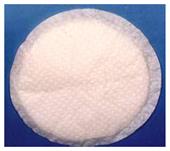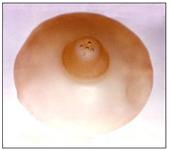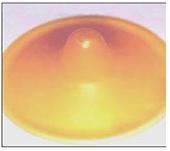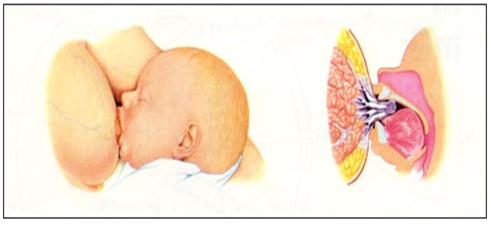수유모의 유방, 젖꼭지에 생긴 통증의 예방과 치료, Preventions and treatments of sore nipples and breasts in breast feedings

사진 4-145. 브라의 안쪽에 넣을 수 있는 수유용 패드
Copyright ⓒ 2011 John Sangwon Lee, MD, FAAP

사진 4-146. 젖꼭지 쉴드
Copyright ⓒ 2011 John Sangwon Lee, MD, FAAP

사진 4-147. 젖꼭지 쉴드
Copyright ⓒ 2011 John Sangwon Lee, MD, FAAP
- 지금까지 유방과 젖꼭지에 생긴 문제를 사전에 예방하거나, 사후 치료하는 방법에 관해서 설명했다.
- 젖꼭지의 문제가 생기기 전에 예방하고 생긴 젖꼭지 문제를 치료하는 방법을 좀 더 구체적으로 정리해본다.
- 임신하기 전, 적어도 임신 초기에 엄마의 젖을 먹여 아기를 키울 것인지, 인공영양을 먹여 아기를 키울 것인지 결정한다.
- 엄마의 젖을 먹여 아기를 키우려면 적어도 임신 4~5개월경부터 젖꼭지를 손으로 마사지해서 젖꼭지를 튼튼하게 한다.
- 이렇게 하면 분만 후 모유를 수유 할 때 젖꼭지가 덜 아프고 덜 갈라지고 진균감염도 덜 생길 수 있다.
- 단, 임신 중 젖꼭지 마사지를 시작하기 전 반드시 의사와 상의해서 젖꼭지 마사지를 해도 되는지 아라야 한다.
- 때로는 젖꼭지 마사지를 해서는 안 되는 경우도 있다. 참고로, 임신 중 젖꼭지 마사지가 아무 이익이 되지 않는다는 연구도 있다.
- 임신 중 임신, 분만, 모유수유에 관한 참고서를 읽거나 임신, 분만 교육과정을 수강해 올바른 모유수유 방법이나 유방 및 젖꼭지 건강관리를 옳게 하는 법을 배워야 한다.
- 특히, 분만 후 모유수유 중 유방이나 젖꼭지가 아프지 않게 하려면 유방과 젖꼭지의 건강관리 법을 제대로 배울 필요가 있다.
- 임신하기 전부터 모유수유를 성공적으로 하기위해 만반 준비를 했던 대부분의 수유모들도 때로는 분만 후 아기에게 젖을 먹일 때 유방이나 젖꼭지가 아파서 많이 고생할 수 있다.
- 수유모들 중 젖꼭지가 갈라지고 거기가 붓고 진물이 나고 아기가 젖꼭지를 빨 때 젖꼭지가 몹시 아프다며 고통을 호소하는 경우가 많다.
- 이 때 갈라진 젖꼭지가 자연적으로 나을 때까지 기다리지 말고 곧바로 의사의 적절한 치료를 받아야 한다.
- 문제가 생겼을 때 바로 치료하지 않으면 갈라진 젖꼭지 상처를 통해 유방에 박테리아 감염이 생겨 감염성 유방염(유선염)이 생길 수 있다.
- 그 감염성 유방염을 적절히 치료하지 않으면 유방 농양이 생길 수 있다.
- 감염성 유방염이나 유방 농양은 적절한 항생제로 응급으로 치료해야 한다. 유방 농양은 수술로 치료 한다.
- 젖꼭지가 갈라진 수유모는 아기에게 젖을 먹을 때 젖꼭지가 또 다시 아플까봐 몹시 걱정하고 긴장하고 겁낸다. 어떤 수유모는 이런 이유로 모유수유를 일시적으로 중단하거나 모유수유를 완전히 중지 한다.
- 수유모가 수유 중 젖꼭지가 아플까봐 걱정을 하고 긴장을 하면 모유가 잘 분비되지 않는다. 설상가상으로 젖 먹는 아기는 젖이 잘나지 않을 때는 젖꼭지를 보통 때보다 더 힘차게 빤다. 때로는 젖꼭지를 물고 당긴다. 이 때 젖꼭지가 더 아프고 더 갈라질 수 있다. 이럴 때 곧 적절히 치료하지 않으면 이런 악순환이 반복되고 더 계속될 것이다.
- 젖꼭지에 이런 문제들이 생기기 전 어떻게 예방할 수 있으며, 이미 문제가 생겼다면 어떻게 적절히 치료할 수 있는지 다음에 정리해봤다.
-
- 젖을 먹이기 전에는 항상 손을 깨끗이 씻는다.
- 매일 목욕이나 샤워를 하고 젖꼭지와 유방을 사워 물로 적시는 정도로 살살 닦는다.
- 젖꼭지를 많이 닦는다든지 자주 닦는 것은 삼간다.
- 특히 비누로 젖꼭지를 많이 씻어서는 안 되며, 알코올로 살균해서도 안 된다.
- 유방과 젖꼭지를 맹물로 씻은 후 될 수 있는 한 공기에 많이 노출시킨다.
- 젖을 먹인 후 다음 번 젖을 먹일 때까지 젖꼭지와 유륜에 라노린 연고나 크림을 발라 젖꼭지와 유륜을 더 부드럽게 할 수 있다. 그렇지만 젖이 나오는 젖꼭지 구멍에 라노린 연고를 발라서는 안 된다.
- 유방에 박테리아 감염병이 생기지 않게 예방하고, 브라가 젖으로 젖지 않도록 브라의 안쪽에 수유용 패드를 넣는다.
- 공기가 잘 유통되는 면직 브라가 더 좋다. 필요에 따라 브라를 자주 바꿔 입는다.
- 아기가 매번 젖을 먹일 때 처음 먹이는 유방의 젖꼭지를 더 힘차게 빤다. 따라서 젖꼭지가 아프고 갈라질 때는 아프지 않은 쪽 젖꼭지를 먼저 빨아먹게 한다. 아프지 않은 젖꼭지를 먼저 빨아먹는 동안 아픈 젖꼭지가 있는 유방 속에 젖이 더 많이 분비되어 젖을 먹일 때 젖이 더 쉽게 나오므로 젖꼭지가 훨씬 덜 아프다.
- 아기가 아픈 젖꼭지가 있는 유방 속 젖을 다 빨아먹지 않고 남기면 남은 젖은 손으로 짜거나 유축기로 짜서 젖병에 담아 냉장고에 적절히 보관했다가 필요에 따라 먹이든지 버린다.
- 젖이 많이 불면 젖꼭지가 더 아플 수 있다. 따라서 모유수유를 보통 때보다 더 자주 하는 것이 좋다. 예를 들어 보통 때 2~3시간마다, 혹은 4시간마다 수유를 했다면 젖꼭지가 아플 때는 1.5~2시간 간격으로 수유한다.
- 젖꼭지가 아프지 않았을 때 한쪽 젖을 10~20분 동안 먹였다면 젖꼭지가 아플 때는 전보다 더 짧게 먹인다. 예를 들면 약 5~10분 동안 먹인다. 이렇게 짧은 시간동안 젖을 먹이면 젖을 충분히 먹지 못해 아기가 쉽게 배고플 수 있다. 이런 경우는 손이나 유축기로 젖을 짜서 젖병에 넣었다가 젖병으로 젖을 먹이든지 보충용 인공영양으로 보충해줄 수 있다(단, 잘못하면 아기가 모유를 더 이상 먹지 않거나, 모유가 잘 분비되지 않아 모유수유를 중단해야 할 때도 있다).
- 아기가 젖을 충분히 먹지 못해 배가 고파 하거나 아픈 젖꼭지를 보통 때보다 더 자주 오래 빤다면, 아픈 젖꼭지를 빨리는 대신 노리개 젖꼭지나 손가락을 빨게 할 수 있다. 이렇게 아픈 젖꼭지를 덜 빨리면 아프고 갈라진 젖꼭지가 더 빨리 낫는다.
- 아픈 젖꼭지에 ‘젖꼭지 쉴드’를 대고 젖을 빨릴 수 있다. 아기가 아픈 젖꼭지를 직접 빠는 대신 젖꼭지 쉴드를 빨아 젖을 먹도록 하는 것이다.
- 단, 어떤 아기는 젖꼭지 쉴드를 빨아 젖을 먹이면 젖을 충분히 먹지 못할 수 있다. 사전에 모유수유 전문가나 단골 의사와 상의한 후 젖꼭지 쉴드를 써서 수유하는 것이 좋다.
- 젖꼭지 쉴드는 플라스틱이나 고무 성분 등으로 만든 인공 젖꼭지의 일종이다. 젖꼭지 쉴드는 한번 사용한 후에 깨끗이 씻고 물에 끓여 살균한 후 다시 쓸 수 있다. (사진 4-12, 4-13 참조)
- 젖꼭지를 물리기 전에 손으로 젖을 조금 짠 다음 젖을 먹이기 시작하면 젖 먹이기가 한결 더 쉽다.
- 젖꼭지가 아프면 타이레놀이나 모트린 등 경구용 진통제로 치료한다.
- 유방이나 젖꼭지가 아프면 아픈 유방과 젖꼭지를 더운물 찜질이나 찬물 찜질로 처치하면 덜 아플 수 있다.
- 갈라진 젖꼭지나 아픈 유방을 전등불 전열이나 헤어드라이기 전열로 치료할 수 있다. 0.5~1m 거리에서 100와트의 전등불 전열로 아픈 젖꼭지를 따뜻하게 공기 찜질을 해주면 더 빨리 좋아질 수 있다. 1회에 15~20분 동안 하루 3~4회 치료한다.
- 아프고 갈라진 젖꼭지를 적절히 치료해도 빨리 낫지 않거나 젖꼭지가 계속 헐고 피가 나고 아프고 유방의 일부가 붉고 전신에 열이 나면 즉시 의사의 진단 및 치료를 받아야 한다. 이 경우 적절한 항생제로 치료하기도 한다.
- 진균 감염병으로 젖꼭지가 아플 때는 니스타틴 연고 등 항 곰팡이 국소치료제로 치료하고, 아기의 입안에 생긴 아구창은 니스타틴 액으로 입안 국소 치료를 한다.
- 갈라진 젖꼭지가 심하게 아파서 젖을 더 이상 먹일 수 없으면 다 나을 때까지 그쪽 젖을 먹이지 않는다. 유방에 괸 젖은 손으로나 유축기로 짜고, 짠 젖을 아기에게 젖병으로 먹이든지 버린다. 모자라는 젖은 보충용 인공영양으로 보충할 수 있다. 아픈 유방이나 갈라진 젖꼭지가 다 나은 후 그 쪽 유방에서 분비되는 젖을 다시 먹일 수 있다.
- 젖꼭지나 유방이 아파 고생을 많이 한 수유모들의 대부분은 모유수유 하는 것을 아예 포기하거나 인공영양을 먹여 아기를 키우기도 한다.
- 특히, 첫 아기에게 모유수유를 했던 수유모는 모유수유를 포기하는 경우가 많다.
- 모유수유를 할 때 이런 어려운 고비를 인내와 용기로 넘겨야 모유수유를 성공적으로 할 수 있다. 그러고 나면 그 보답이 얼마나 큰지 가늠할 수 없다.
- ‘고통 없이 얻는 것이 없다(No pain, no gain)’.

그림 4-30. 함몰 젖꼭지(좌)와 갈라진 젖꼭지(우)
사진 출처 Used with permission from Ross Laboratories, Columbus, OH, USA 또는 소아가정간호백과

그림 4-31. 아기의 아래위 잇몸을 유륜에 가까이 대고 아기의 입 속에 젖꼭지가 들어가 있는 상태로 젖을 먹인다.
사진 출처 Used with permission from Ross Laboratories, Columbus, Ohio 43216, Division of Laboratories, USA 또는 소아가정간호백과
Preventions and treatments of sore nipples and breasts in breastfeedings 수유모의 유방, 젖꼭지에 생긴 통증의 예방과 치료

Photo 4-145. Nursing pads that can be placed inside the bra. Copyright ⓒ 2011 John Sangwon Lee, MD, FAAP

Photo 4-146. Nipple shield. Copyright ⓒ 2011 John Sangwon Lee, MD, FAAP

Photo 4-147. Nipple shield. Copyright ⓒ 2011 John Sangwon Lee, MD, FAAP
So far, we have explained how to prevent or treat breast and nipple problems in advance.
Before developing a nipple problem, let’s take a closer look at how to prevent and treat nipple problems.
Before pregnancy, at least in the early stages of pregnancy, decide whether to feed the baby with the mother’s breast milk or feed the baby with artificial nutrition.
In order to raise the baby by feeding the mother’s breast milk, at least 4-5 months pregnant, massage her nipples by hand to strengthen the nipples.
This will make your nipples sore less painful and less cracked and less fungal infections when breastfeeding after delivery.
However, before starting a nipple massage during pregnancy, you must consult with your doctor to know if you can do a nipple massage. Sometimes you shouldn’t do a nipple massage.
For reference, there are studies showing that nipple massage during pregnancy is of no benefit.
During pregnancy, you should read reference books on pregnancy, childbirth, and breastfeeding, or take pregnancy and childbirth training courses to learn the correct breastfeeding method or the correct breast and nipple health care.
In particular, it is necessary to properly learn how to care for breasts and nipples to prevent pain in the breasts or nipples during breastfeeding after delivery.
Most nursing mothers, who have been fully prepared to successfully breastfeed before pregnancy, can sometimes suffer a lot from pain in breasts or nipples when breastfeeding their baby after delivery.
Breastfeeding mothers often complain of pain when the nipples are cracked, swelling, and the nipples hurt very much when the baby sucks.
At this time, do not wait for the cracked nipple to heal naturally, and seek appropriate medical attention immediately.
If a problem arises and is not treated immediately, a bacterial infection in the breast through a cracked nipple wound can lead to infectious mastitis.
If the infectious mastitis is not treated properly, it can lead to a breast abscess. Infectious mastitis or breast abscess should be treated as an emergency with appropriate antibiotics.
Breast abscesses are treated surgically.
Breastfeeding mothers with cracked nipples are very worried, tense, and frightened that the nipples will hurt again when feeding the baby.
For this reason, some nursing mothers temporarily stop breastfeeding or stop breastfeeding completely.
If a nursing mother is worried that her nipples will hurt while breastfeeding and is nervous, breast milk is difficult to secrete.
To make matters worse, breastfeeding babies suck their nipples harder than usual when breastfeeding is difficult.
Sometimes it bites and pulls the nipple.
At this point, the nipples may hurt more and more cracked.
In this case, if not treated properly soon, this vicious cycle will repeat and continue. Here’s how you can prevent these problems with your nipples and how to properly treat them if you already have a problem.
Always wash your hands thoroughly before feeding.
Take a bath or shower every day and gently wipe your nipples and breasts soaked in warm water. Avoid wiping your nipples a lot or frequently.
In particular, you shouldn’t wash your nipples much with soap, and you shouldn’t sterilize them with alcohol.
After washing your breasts and nipples with plain water, expose as much to the air as possible.
After breastfeeding, the nipples and areolas can be softened by applying lanolin ointment or cream to the nipples and areolas until the next breastfeeding.
However, you should not apply Lanorine ointment to the nipple hole where the milk comes from.
To prevent bacterial infectious diseases in the breast, put a nursing pad inside the bra to prevent it from getting wet with breast milk.
A cotton bra with good air circulation is better. Change your bra often as needed. Whenever your baby is breastfeeding, suck the nipples in the first breast more vigorously.
Therefore, when the nipple hurts and cracks, suck the nipple on the side that does not hurt first.
The nipples are much less painful as the breasts with sore nipples secrete more milk while sucking the non-pain nipples first, making the milk easier to come out when breastfeeding.
If the baby doesn’t suck up all the milk in the breast with a sore nipple, squeeze the remaining milk with hand or squeeze it with a breast pump, put it in a bottle, store it in the refrigerator properly, and feed it or throw it away as needed. If you have a lot of milk, your nipples can hurt more.
Therefore, it is better to breastfeed more often than usual.
For example, if you normally breastfeed every 2 to 3 hours or every 4 hours, if your nipples hurt, you should breastfeed every 1.5 to 2 hours.
If one breast is fed for 10 to 20 minutes when the nipple is not sore, the nipple is fed shorter than before. For example, feed for about 5-10 minutes.
If you breastfeed for such a short period of time, you may not be able to get enough milk and your baby can easily become hungry. In this case, you can express milk with your hand or breast pump and place it in a bottle and then feed it with a bottle, or supplement with artificial nutrition for supplementation.
If your baby is hungry because she doesn’t get enough breast milk, or if she sucks a sore nipple more often than usual, you may want to suck a soother or a finger instead of quickening the sore nipple.
If you can suck the breast by putting a “nipple shield” on the sore nipple, painful nipples like this will heal less quickly.
Instead of sucking the sore nipple directly, the baby is forced to suck on the nipple shield to breastfeed. However, some babies may not be able to get enough breast milk if they suck on the nipple shield.
It is better to use a nipple shield to breastfeed after consulting with a breastfeeding expert or regular doctor in advance.
The nipple shield is a kind of artificial nipple made of plastic or rubber. The nipple shield can be reused after being washed thoroughly after use, boiled in water, and sterilized. (Refer to photo 4-12, 4-13)
Breastfeeding is much easier if you express a little breast milk by hand before biting the nipple and then start breastfeeding.
If your nipples hurt, treat them with oral pain relievers such as Tylenol or Motrin. If your breasts or nipples hurt, you may feel less painful if you treat the sore breasts and nipples with a hot or cold compress. Cracked nipples or sore breasts can be treated with lamp heat or a hairdryer heat.
You can get better sooner if you warm the sore nipples with a 100-watt lamp heat at a distance of 0.5 to 1m.
Treat 3-4 times a day for 15-20 minutes at a time. If your sore and cracked nipples do not heal quickly even after proper treatment, or if your nipples continue to break, bleed, sore, part of the breast is red, and you have a fever all over the body, you should immediately seek medical attention and treatment. In this case, it is sometimes treated with appropriate antibiotics.
When the nipple hurts due to a fungal infection, treat it with topical antifungal treatments such as nystatin ointment, and treat thrush in the baby’s mouth with nystatin solution.
If the cracked nipple is so painful that you can no longer breastfeed, do not feed it until it is healed. Squeeze the breast with your hands or with a breast pump, and feed the baby with a bottle or throw it away.
It can be supplemented with artificial nutrition for wet supplementation. After the sore breast or cracked nipple is healed, you can refeed the milk from that breast.
Most of the nursing mothers who have suffered a lot because of a nipple or breast ache either give up breastfeeding altogether or feed artificial nutrition to raise their babies.
In particular, nursing mothers who breastfeed their first baby often give up breastfeeding. When breastfeeding, you must overcome these difficult challenges with patience and courage to successfully breastfeed.
After that, you can’t figure out how big the reward will be. ‘No pain, no gain’.

Figure 4-30. Depressed nipple (left) and split nipple (right)
Photo source. Used with permission from Ross Laboratories, Columbus, OH, USA or Pediatric Family Nursing Encyclopedia

Figure 4-31. Put the baby’s lower and upper gums close to the areola and feed the baby with the nipple in his mouth.
Photo Source. Used with permission from Ross Laboratories, Columbus, Ohio 43216, Division of Laboratories, USA or Pediatric Family Nursing Encyclopedia
출처 및 참조 문헌
- NelsonTextbook of Pediatrics 22ND Ed
- The Harriet Lane Handbook 22ND Ed
- Growth and development of the children
- Red Book 32nd Ed 2021-2024
- www.drleepediatrics.com 제1권 소아청소년 응급 의료
- www.drleepediatrics.com 제2권 소아청소년 예방
- www.drleepediatrics.com 제3권 소아청소년 성장 발육 육아
- www.drleepediatrics.com 제4권 모유,모유수유, 이유
- www.drleepediatrics.com 제5권 인공영양, 우유, 이유식, 비타민, 미네랄, 단백질, 탄수화물, 지방
- www.drleepediatrics.com 제6권 신생아 성장 발육 육아 질병
- www.drleepediatrics.com제7권 소아청소년 감염병
- www.drleepediatrics.com제8권 소아청소년 호흡기 질환
- www.drleepediatrics.com제9권 소아청소년 소화기 질환
- www.drleepediatrics.com제10권. 소아청소년 신장 비뇨 생식기 질환
- www.drleepediatrics.com제11권. 소아청소년 심장 혈관계 질환
- www.drleepediatrics.com제12권. 소아청소년 신경 정신 질환, 행동 수면 문제
- www.drleepediatrics.com제13권. 소아청소년 혈액, 림프, 종양 질환
- www.drleepediatrics.com제14권. 소아청소년 내분비, 유전, 염색체, 대사, 희귀병
- www.drleepediatrics.com제15권. 소아청소년 알레르기, 자가 면역질환
- www.drleepediatrics.com제16권. 소아청소년 정형외과 질환
- www.drleepediatrics.com제17권. 소아청소년 피부 질환
- www.drleepediatrics.com제18권. 소아청소년 이비인후(귀 코 인두 후두) 질환
- www.drleepediatrics.com제19권. 소아청소년 안과 (눈)질환
- www.drleepediatrics.com 제20권 소아청소년 이 (치아)질환
- www.drleepediatrics.com 제21권 소아청소년 가정 학교 간호
- www.drleepediatrics.com 제22권 아들 딸 이렇게 사랑해 키우세요
- www.drleepediatrics.com 제23권 사춘기 아이들의 성장 발육 질병
- www.drleepediatrics.com 제24권 소아청소년 성교육
- www.drleepediatrics.com 제25권 임신, 분만, 출산, 신생아 돌보기
- Red book 29th-31st edition 2021
- Nelson Text Book of Pediatrics 19th- 21st Edition
- The Johns Hopkins Hospital, The Harriet Lane Handbook, 22nd edition
- 응급환자관리 정담미디어
-
소아가정간호백과–부모도 반의사가 되어야 한다, 이상원
-
Neonatal Resuscitation American heart Association
-
Neonatology Jeffrey J.Pomerance, C. Joan Richardson
-
Pediatric Resuscitation Pediatric Clinics of North America, Stephen M. Schexnayder, M.D.
-
Pediatric Critical Care, Pediatric Clinics of North America, James P. Orlowski, M.D.
-
Preparation for Birth. Beverly Savage and Dianna Smith
-
Infectious disease of children, Saul Krugman, Samuel L Katz, Ann A. Gershon, Catherine Wilfert
- Pediatric Nutritional Handbook American Academy of Pediatrics
- 소아가정간호백과–부모도 반의사가 되어야 한다, 이상원
- The pregnancy Bible. By Joan stone, MD. Keith Eddleman, MD
- Neonatology Jeffrey J. Pomerance, C. Joan Richardson
- Preparation for Birth. Beverly Savage and Dianna Smith
- 임신에서 신생아 돌보기까지. 이상원
- Breastfeeding by Ruth Lawrence and Robert Lawrence
- Infectious disease of children, Saul Krugman, Samuel L Katz, Ann A. Gershon, Catherine Wilfert
- The Harriet Lane Handbook 19th Edition
- 제4권 모유, 모유수유, 이유 참조문헌 및 출처
- 제5권 인공영양, 우유, 이유, 비타민, 단백질, 지방 탄수 화물 참조문헌 및 출처
- 제6권 신생아 성장발육 양호 질병 참조문헌 및 출처
- 소아과학 대한교과서
- 그 외
|
Copyright ⓒ 2015 John Sangwon Lee, MD, FAAP 미국 소아과 전문의, 한국 소아청소년과 전문의 이상원 저 “부모도 반의사가 되어야 한다”-내용은 여러분들의 의사로부터 얻은 정보와 진료를 대신할 수 없습니다. “The information contained in this publication should not be used as a substitute for the medical care and advice of your doctor. There may be variations in treatment that your doctor may recommend based on individual facts and circumstances. “Parental education is the best medicine.” |